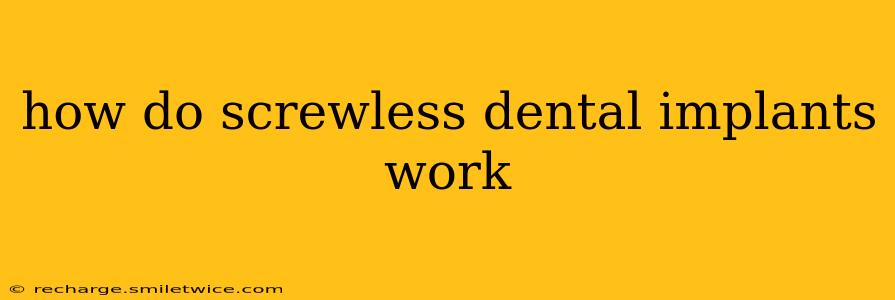Screwless dental implants, also known as implant-supported fixed prostheses, offer a revolutionary approach to tooth replacement, eliminating the need for traditional screw-retained crowns. This innovative technique provides a secure and aesthetically pleasing solution for patients seeking a permanent replacement for missing teeth. But how do they actually work? This comprehensive guide will delve into the mechanics, benefits, and considerations of this increasingly popular dental procedure.
What are Screwless Dental Implants?
Unlike traditional implants where a crown is screwed onto the implant abutment, screwless implants utilize a different method of attachment. They employ a cement-retained or press-fit method to secure the prosthetic teeth to the implant fixture. This means the crown is cemented or pressed onto the abutment, creating a seamless and monolithic restoration.
How is a Screwless Dental Implant Placed?
The procedure for placing screwless dental implants follows a similar initial process to traditional implants:
-
Initial Consultation and Assessment: Your dentist will perform a thorough examination, including X-rays and possibly a 3D scan (CBCT), to assess bone density and determine the suitability of screwless implants.
-
Implant Placement Surgery: Similar to traditional implants, the surgeon will create a small incision in the gum tissue, place the implant fixture into the jawbone, and suture the gums closed. This part of the process is almost identical for screwless and screw-retained implants.
-
Abutment Placement: Once the implant has osseointegrated (fused with the jawbone), the abutment is placed. This is the part that connects the implant to the crown.
-
Crown Fabrication and Cementation/Press-Fit: A highly accurate impression is taken to create a custom-made crown. This crown is then cemented onto the abutment using dental cement or, in some cases, it's designed for a press-fit connection.
What are the Advantages of Screwless Dental Implants?
Screwless dental implants offer several advantages:
-
Improved Aesthetics: The absence of a screw access hole on the crown results in a more natural and aesthetically pleasing appearance. The crown sits seamlessly on the abutment, mimicking the look and feel of a natural tooth.
-
Reduced Risk of Screw Loosening: One of the potential complications with traditional screw-retained implants is screw loosening. Screwless implants eliminate this risk entirely, as there's no screw to become loose or damaged.
-
Simplified Maintenance: Because there’s no screw to potentially work loose, maintenance and cleaning can be easier, as the crown sits more securely in place.
-
Stronger Connection (potentially): In many cases, the cement or press-fit connection can create a very strong and stable connection between the abutment and the crown.
Are Screwless Dental Implants Right for Everyone?
While screwless implants offer many advantages, they are not suitable for every patient. The suitability depends on several factors, including:
-
Bone Density: Adequate bone density is essential for successful implant placement. If bone grafting is needed, traditional screw-retained implants might be preferred due to the added strength the screw provides.
-
Bite Force: Patients with a very strong bite might benefit more from the security offered by a screw-retained implant.
-
Surgical Skill: The success of cement-retained restorations depends on the precision of the dentist’s work. Finding an experienced dentist proficient in this technique is crucial.
-
Cement type: The longevity of the cement-retained crown depends on the type and quality of the dental cement used.
What are the Potential Disadvantages?
-
Cement Failure: Cement failure, though rare with modern cements, remains a possibility. If the cement fails, the crown can come loose.
-
Difficulty in Removal: If the crown needs to be removed for any reason, it can be more challenging to do so compared to a screw-retained implant.
How Much Do Screwless Dental Implants Cost?
The cost of screwless dental implants varies depending on several factors, including the location, the dentist's fees, the number of implants needed, and any necessary preparatory procedures. It's always best to consult with your dentist for a personalized cost estimate.
How Long Do Screwless Dental Implants Last?
With proper oral hygiene and regular dental checkups, screwless dental implants can last for many years, potentially a lifetime. However, the longevity depends on several factors, including individual oral health habits, overall health, and the quality of the materials used.
How to Care for Screwless Dental Implants?
Maintaining good oral hygiene is crucial for the long-term success of screwless dental implants. This includes brushing twice daily with fluoride toothpaste, flossing regularly, and using an antimicrobial mouthwash. Regular dental checkups and professional cleanings are also essential.
This guide provides a comprehensive overview of screwless dental implants. Remember to consult with a qualified dental professional to determine the best treatment plan for your individual needs and circumstances. They can assess your specific situation and help you make an informed decision.
